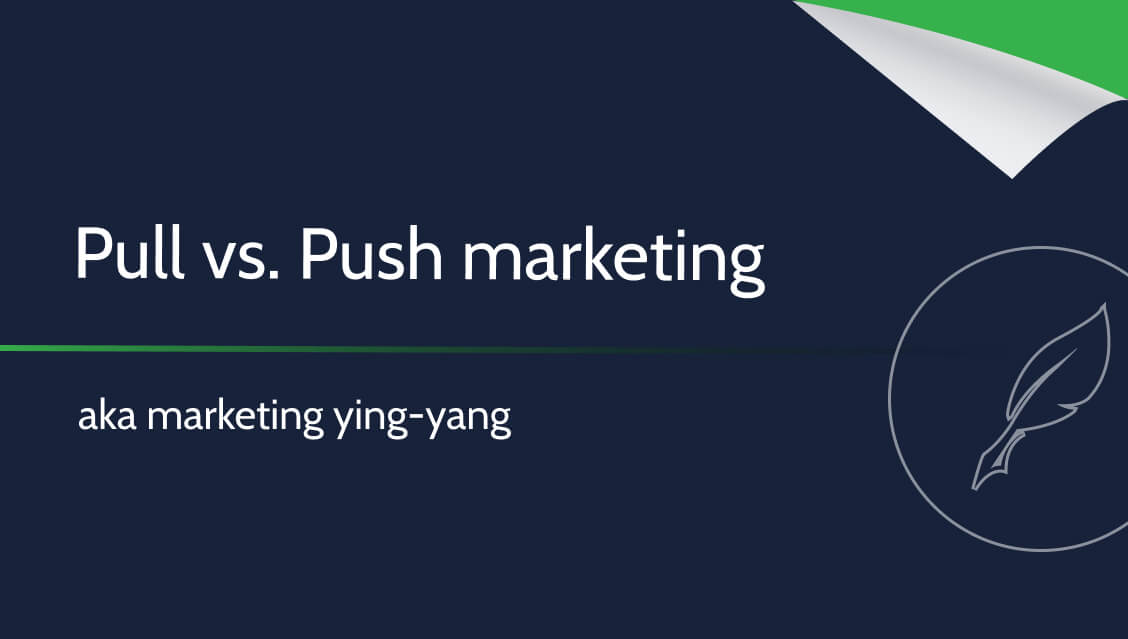Pull vs. Push marketing – aka marketing ying-yang

This entry will be devoted to a purely marketing issue – we will discuss the differences between the so-called ‘push’ and ‘pull’ strategies. They sound like natural opposites, but are they really? The answer is in the article below.
Pull and Push marketing… what is it really about?
Marketing is an extremely extensive field, so it is not surprising that a significant number of concepts have been developed to serve one primary purpose – advertising a given product to a potential customer. There are many ideas, and some of them – seemingly – present a completely different approach to the same topic. Such a duo is pull and push marketing, which differ in the way they reach the customer and interact with him. We explain the details below.
What is push marketing?
Push in English means “to push” and also reflects the specificity of this concept.
Manufacturers try to ‘push’ or, perhaps more appropriately, ‘suggest’ their new product to potential customers in hopes of improving sales and increasing consumer awareness of a given brand.
These are all kinds of activities, sometimes ‘invasive’ in their own way, intended to present us something new. Examples include traditional sales activities (the salesperson visits potential customers’ homes and presents the product) or employing people at stands in large shopping malls who encourage people to see samples.
This is a necessary solution for new companies that do not yet have an established reputation and consumer awareness of their activities is very low. However, this is not the only opportunity to take advantage of it – actions taken by large brands include, for example, a temporary price reduction on part of the offered assortment. Push marketing is also a beneficial strategy if we offer a product that customers purchase on a momentary impulse.
To sum up, in push marketing we start from the perspective of a finished product that must be attractively presented. Of course, there is also an opposite approach, in which we start from the perspective of the customer’s needs who are looking for a solution to their problem.
See also
And what is pull marketing?
After reading the above section about push marketing, it will not be difficult for us to answer this question.
Pull marketing assumes attracting new customers to our product – that is, presenting it as a solution to an existing problem and creating a need for it among recipients.
The sales model and customer relations also differ. While push marketing assumes ‘impulsiveness’ of sales and short-term profits, the idea of pull marketing is to create a permanent, faithful group of recipients who will remain loyal and will repeatedly use the services – or buy new products – of a given company.
Due to the focus on ‘long-term’ results, pull marketing campaigns require a large financial outlay and the use of many possible means. The goal is to create an ‘icon’ from the brand.
A popular carbonated drink is considered by many people to be the best thing we can drink on hot days. In turn, a clothing brand may be associated with clothing for mountain climbing – and so on.
So, in principle, although we spend significant amounts of money on advertising, we gain reputation.
For this reason, this strategy is less accessible to smaller companies or those that have recently started operations – it is difficult to build recognition on a name that has not yet had a chance to become known in the broadly understood consumer consciousness.
See also
Pull, push… or maybe both?
Although the concepts described above assume a completely different approach to the topic, their goal is common. Therefore, it is possible to use both of them – either in a mix or alternately – to increase your chances of success.
Let’s check how this can work in practice. Thanks to the push concept, we can create a need in the recipient. Then we use different tools and use pull marketing to present ourselves as a response to this need. This model, although simple, can be an effective tactic.
Our initial marketing efforts should center around the concept of push. The possibilities, especially in the era of widespread use of the Internet for many types of consumer activities, are truly wide.
We can arrange the previously mentioned opportunity to introduce the customer to the product “face to face” – either at advertising stands or organized meetings. If we have a database of people, we can send them e-mails. Social media accounts and paid online advertising are also an obvious idea.
After gathering a permanent group of recipients, we can start incorporating elements of pull marketing into our activities. An example is encouraging current customers to leave ratings, which will help increase the popularity of our products. Another strategy is to incorporate user generated content elements into our campaigns.
Summary
- We hope that the above article presented pull and push marketing as compatible concepts, not mutually exclusive ones.
- After all, the primary goal of advertising activities is to sell a product or service.
- There are many paths to this, and choosing one does not limit us to the others – it is worth always keeping this in mind when planning subsequent campaigns.

















Leave a Reply